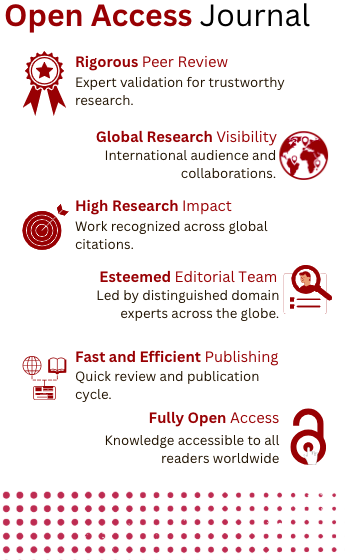Drug Side Effect Prediction Using Supervised Machine Learning Techniques
Keywords:
Supervised Learning, Machine Learning, Logistic Regression, Linear SVM, Random ForestAbstract
In the pharmaceutical sector, drug combinations are now a popular research issue, but experiment-based approaches are quite expensive in terms of both time and money. Many computational techniques have been put out to tackle these issues by beginning with current pharmacological combinations. To properly evaluate medication combinations, however, only chemical structure information is often provided, covering a rather narrow range of pharmacological properties. By combining the neighbour recommender approach with ensemble learning algorithms, we incorporated similarity-based multi-feature drug data to increase prediction accuracy. We chose the best medication characteristics by feature evaluation analysis, achieving an accuracy of 0.801 in the ensemble models. . Results of the study demonstrated that ensemble models outperformed conventional machine learning techniques including support vector machines (SVM), random forests (RF), and logistic regression (GLM). Additionally, we predicted 10 potential medication combinations for the medicine paclitaxel, and we were able to effectively confirm that two of the anticipated combinations have positive outcomes. The goal of this project take the input data from user and predict the side effects accurately automatic.
References
Fayyad, J., Jaradat, M. A., Gruyer, D., & Najjaran, H. (2020). Deep learning sensor fusion for autonomous vehicle perception and localization: A review. Sensors, 20(15), 4220.
Deng, L., & Li, X. (2013). Machine learning paradigms for speech recognition: An overview. IEEE Transactions on Audio, Speech, and Language Processing, 21(5), 1060-1089.
Afouras, T., Chung, J. S., Senior, A., Vinyals, O., & Zisserman, A. (2018). Deep audio-visual speech recognition. IEEE transactions on pattern analysis and machine intelligence.
Joachims, T., & Radlinski, F. (2007). Search engines that learn from implicit feedback. Computer, 40(8), 34-40.
Morgan, S., Grootendorst, P., Lexchin, J., Cunningham, C., & Greyson, D. (2011). The cost of drug development: a systematic review. Health policy, 100(1), 4-17.
Ng, H. W., Zhang, W., Shu, M., Luo, H., Ge, W., Perkins, R., ... & Hong, H. (2014, December). Competitive molecular docking approach for predicting estrogen receptor subtype α agonists and antagonists. In BMC bioinformatics (Vol. 15, No. 11, pp. 1-15). BioMed Central.
Ng, H. W., Shu, M., Luo, H., Ye, H., Ge, W., Perkins, R., ... & Hong, H. (2015). Estrogenic activity data extraction and in silico prediction show the endocrine disruption potential of bisphenol A replacement compounds. Chemical research in toxicology, 28(9), 1784-1795.
Hong, H., Neamati, N., Winslow, H. E., Christensen, J. L., Orr, A., Pommier, Y., & Milne, G. W. A. (1998). Identification of HIV-1 integrase inhibitors based on a four-point pharmacophore. Antiviral Chemistry and Chemotherapy, 9(6), 461-472.
Hong, H., Tong, W., Xie, Q., Fang, H., & Perkins, R. (2005). An in silico ensemble method for lead discovery: decision forest. SAR and QSAR in Environmental Research, 16(4), 339-347.
Hong, H., Fang, H., Xie, Q., Perkins, R., Sheehan, D. M., & Tong, W. (2003). Comparative molecular field analysis (CoMFA) model using a large diverse set of natural, synthetic and environmental chemicals for binding to the androgen receptor. SAR and QSAR in Environmental Research, 14(5-6), 373-388.
Lo, Y. C., Rensi, S. E., Torng, W., & Altman, R. B. (2018). Machine learning in chemoinformatics and drug discovery. Drug discovery today, 23(8), 1538-1546.
Talevi, A., Morales, J. F., Hather, G., Podichetty, J. T., Kim, S., Bloomingdale, P. C., ... & Conrado, D. J. (2020). Machine learning in drug discovery and development part 1: a primer. CPT: pharmacometrics & systems pharmacology, 9(3), 129-142.
Gertrudes, J. C., Maltarollo, V. G., Silva, R. A., Oliveira, P. R., Honorio, K. M., & Da Silva, A. B. F. (2012). Machine learning techniques and drug design. Current medicinal chemistry, 19(25), 4289-4297.
Agarwal, S., Dugar, D., & Sengupta, S. (2010). Ranking chemical structures for drug discovery: a new machine learning approach. Journal of chemical information and modeling, 50(5), 716-731.
Rodrigues, T., & Bernardes, G. J. (2020). Machine learning for target discovery in drug development. Current Opinion in Chemical Biology, 56, 16-22.
Gao, D., Chen, Q., Zeng, Y., Jiang, M., & Zhang, Y. (2020). Applications of machine learning in drug target discovery. Current Drug Metabolism, 21(10), 790-803.
Vamathevan, J., Clark, D., Czodrowski, P., Dunham, I., Ferran, E., Lee, G., ... & Zhao, S. (2019). Applications of machine learning in drug discovery and development. Nature reviews Drug discovery, 18(6), 463-477.
Zoffmann, S., Vercruysse, M., Benmansour, F., Maunz, A., Wolf, L., Blum Marti, R., ... & Prunotto, M. (2019). Machine learning-powered antibiotics phenotypic drug discovery. Scientific reports, 9(1), 1-14.
Ekins, S., Puhl, A. C., Zorn, K. M., Lane, T. R., Russo, D. P., Klein, J. J., ... & Clark, A. M. (2019). Exploiting machine learning for end-to-end drug discovery and development. Nature materials, 18(5), 435-441.
Kumar Raja, D. R., Hemanth Kumar, G., Basha, S. M., & Ahmed, S. T. (2022). Recommendations based on Integrated Matrix Time Decomposition and Clustering Optimization. International Journal of Performability Engineering, 18(4).
Kumar, S. S., Ahmed, S. T., Xin, Q., Sandeep, S., Madheswaran, M., & Basha, S. M. Unstructured Oncological Image Cluster Identification Using Improved Unsupervised Clustering Techniques.
Ahmed, S. T., Singh, D. K., Basha, S. M., Abouel Nasr, E., Kamrani, A. K., & Aboudaif, M. K. (2021). Neural network based mental depression identification and sentiments classification technique from speech signals: A COVID-19 Focused Pandemic Study. Frontiers in public health, 9, 781827.
Downloads
Published
How to Cite
Issue
Section
License
Copyright (c) 2022 M Pushpanjali, A Srinivasan, Y Sreeraman

This work is licensed under a Creative Commons Attribution-NonCommercial-NoDerivatives 4.0 International License.



